
With art being subjective, and me being anything but an expert, this list might not please everyone. But if you want to find the best art in Vienna, then consider starting with these suggestions…
- See also:
The Kiss
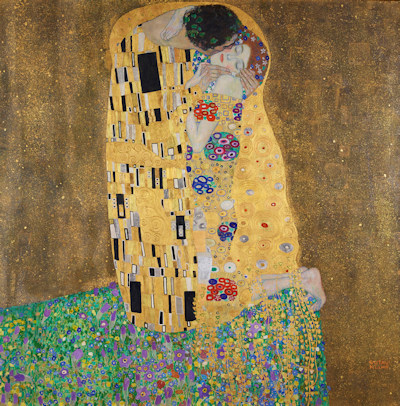
The Kiss (photo courtesy of and © Belvedere, Wien. Reproduced with permission under the terms of Creative Commons License CC BY-SA 4.0.)
Obvious, but still true.
Klimt’s seminal The Kiss might plausibly make it into a global Top 10 works of art. Austria’s Mona Lisa. The Everest of the Viennese art landscape. Nothing comes close in terms of importance.
See the 1907/1908 painting in the wonderful Upper Belvedere palace, where it rubs shoulders with works from the likes of Rodin, Schiele, Van Gogh, and others.
And if you can’t afford the real thing, a million Kiss-themed mugs, t-shirts, etc. grace museum and souvenir shops throughout the city.
The Young Hare

(Albrecht Dürer, Hare, 1502; watercolor and gouache, brush, heightened with white gouache © The Albertina Museum, Vienna)
Well, if The Kiss is Everest, then Albrecht Dürer’s Young Hare in the Albertina museum is K2. A masterpiece from 1502, where the animal almost threatens to jump out of the frame such is the realism.
Unfortunately, even the healthiest of hares eventually shows its age. Given the work’s delicacy, Dürer’s work only appears every couple of years or so in special exhibitions. But you might be lucky on your visit.
The Bruegels
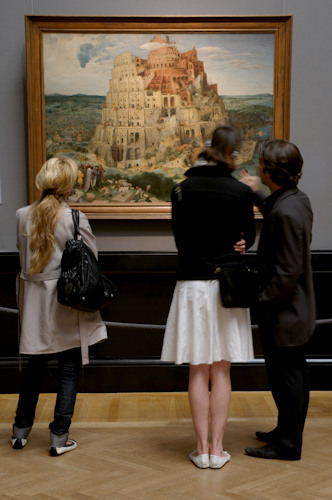
(Tower of Babel in the Picture Gallery © KHM-Museumsverband)
Completing a triumvirate of what you might call truly world-class art, the Kunsthistorisches Museum’s Bruegel collection finds no comparison elsewhere.
The museum owns twelve of his paintings, including several that even those with a mere passing interest in art might recognise: the 1563 Tower of Babel, the 1560 Children’s Games and the 1568 Peasant Wedding.
While the works of Pieter Bruegel the Elder represent the icing on the canvas cake, the museum’s picture gallery reads like a who’s who of 15th to 18th-century European artists: from Arcimboldo to Van Dyck via Titian, Raffael, Caravaggio, Rembrandt, and many others.
The Venus of Willendorf
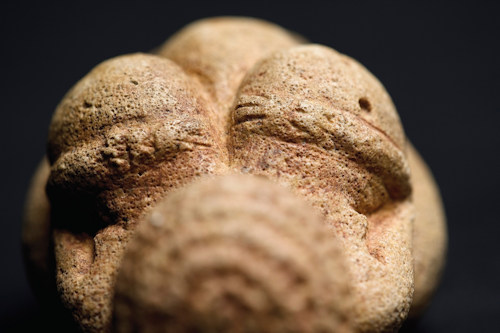
(Press photo courtesy of and © Naturhistorisches Museum Wien)
Dürer and Bruegel represent mere babes of art history compared to the anonymous sculptor who created the Venus of Willendorf.
This tiny limestone image of a woman appeared around 29,000 years before Albrecht and Pieter picked up their first charcoal sticks.
The Venus enjoys her twilight years in the relaxing surrounds of the Naturhistorisches Museum, also home to my next recommended work of art…
The gemstone bouquet
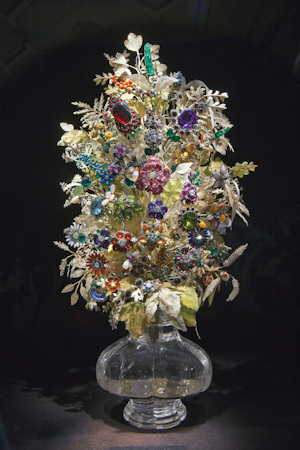
(Photo courtesy of and copyright Naturhistorisches Museum Wien)
Habsburg monarchs rarely went for gift vouchers and a bottle of wine when it came to presents for their spouses.
Maria Theresa, for example, presented her husband, Franz Stephan, with a rather nice bunch of flowers one day in the 1760s.
If flowers sound surprisingly cheap, then consider that this particular 50cm bouquet consisted entirely of silk and gemstones. Including over 2000 diamonds.
Even the insects crawling across the blooms turn out to be glorious creations of the gemcutter’s art.
The Saliera
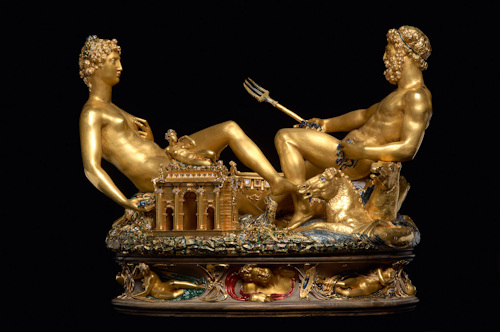
(Salt cellar (Saliera) Benvenuto Cellini 1540-1543, Paris, gold, enamel, ebony, ivory 26.3 cm x 28.5 cm x 21.5 cm © Kunsthistorisches Museum Wien)
Vienna’s Kunsthistorisches Museum enjoys a fine reputation for the quality of its paintings, and I already mentioned the Bruegels.
Those hallowed galleries also feature a few three-dimensional joys, too. Like, for example, the 16th-century Saliera.
This gift from France’s Charles IX to Archduke Ferdinand II of Tyrol is just like your salt and pepper pot at home.
If your salt and pepper pot contains enough gold to make a dent in the national debt and also represents an allegorical portrayal of land and sea.
So probably not like the one at home.
The crown of the Austrian Empire
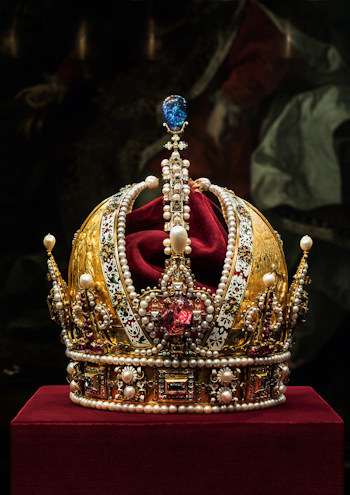
(The Crown of Rudolf II, later Crown of the Austrian Empire, Jan Vermeyen, Prague, 1602 ©KHM-Museumsverband)
Let’s stick with 3D and gold for a moment.
As you might expect, the Schatzkammer Imperial Treasury in Vienna owns a few, well, treasures. Think 2,680 carat emeralds, the coronation robes of the Holy Roman Emperor or, perhaps most notably, what we might call the Austrian crown.
Created for Emperor Rudolf II in 1602, this headwear in gold, pearl and diamond is the imperial way of saying, “my empire is significantly bigger than yours”.
The Last Judgment
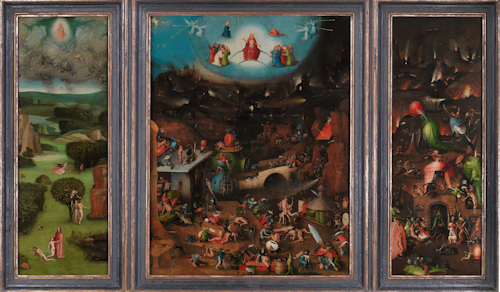
(Hieronymus Bosch, Weltgerichts-Triptychon, um 1490 – um 1505, Öltempera auf Eiche © Gemäldegalerie der Akademie der bildenden Künste Wien)
One of the greatest works by Hieronymus Bosch belongs not to any Viennese art museum, but to a university: the Academy of Fine Arts Vienna.
Bosch’s early 16th-century triptych, The Last Judgment, forms the highlight of the academy’s picture gallery.
The Academy hosts a series of public exhibitions that usually juxtapose a selection of its historical and contemporary art. But (I think) the Bosch work always makes an appearance.
The panel paintings certainly live up to the public perception of Bosch. A detailed mix of men and demons, strange forms and bizarre acts of torture…all interspersed with benign views of angels and the heavens. Paintings to get lost in as you discover the themes and imagination of the artist.
The No. 14 chair
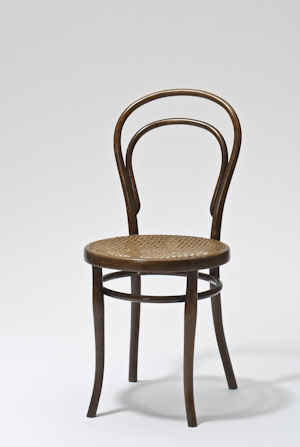
(Gebrüder Thonet, Chair, Model No. 14, Vienna, 1859 (Execution: 1890–1918) © MAK/Georg Mayer)
And at the other end of the scale comes the lowly chair. Not something you traditionally associate with great art.
Step forward the Thonet No. 14 chair, though: a true triumph of design, engineering (and marketing).
The chair revolutionised furniture production and sold in its millions; all with the simple elegance of a few bits of curved wood.
Examples normally appear in the permanent exhibitions of the MAK museum and the Vienna Furniture Museum.
The quetzal headdress

(The quetzal-feather headdress; photo © KHM-Museumsverband)
The last remaining quetzal feather headdress from the Aztec culture finds a surprising home in Vienna’s Weltmuseum. This fact has, at times, led to what we might call robust discussions between Austria and Mexico.
The huge shimmering early 16th-century masterpiece measures some 116cm by 175cm, replete with feathers from several different bird species and bound together in gold and other materials.
Vienna
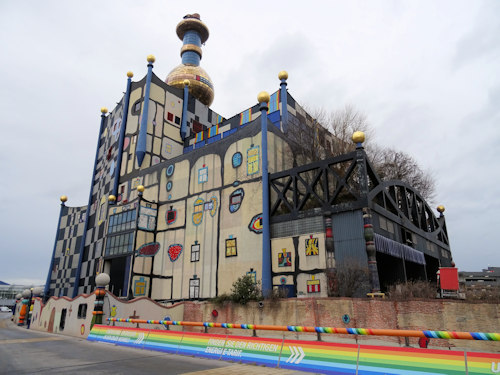
(The municipal incinerator at Spittelau, designed by Hundertwasser)
Call me twee but the bonus place in my Top Ten list goes to the city itself. (I’m a little biased, especially as I try and see beauty everywhere.)
Wander the streets of the old town and allow yourself to fall into the warm embrace of a traditional coffee house. The lifestyle is a work of art in its own right, honed through decades of diligent repose in upholstered seats: drink in one hand, newspaper in another.
Like any big city, Vienna presents a jumble of competing art forms (albeit heavy on the historicism).
You find artistic endeavour everywhere here. In the historical buildings, the street art at the Danube Canal, the bright curves of Hundertwasser’s iconoclastic architecture, the flower arrangements in the city parks, the Jugendstil houses,…(I’ll stop there).
Enjoy it.